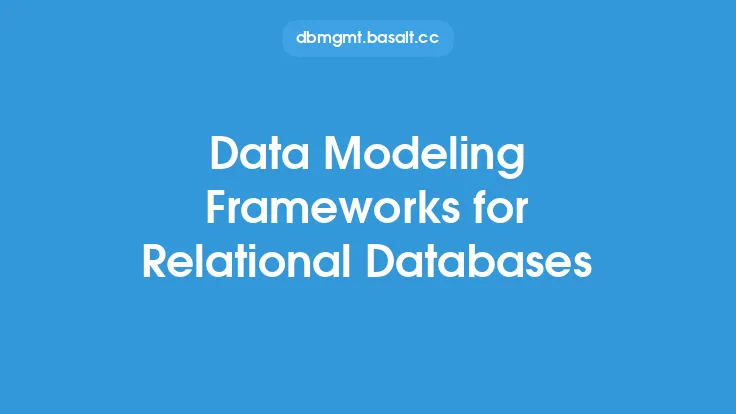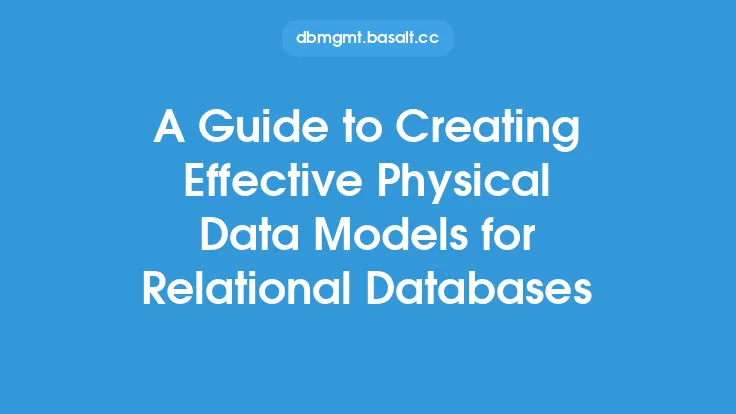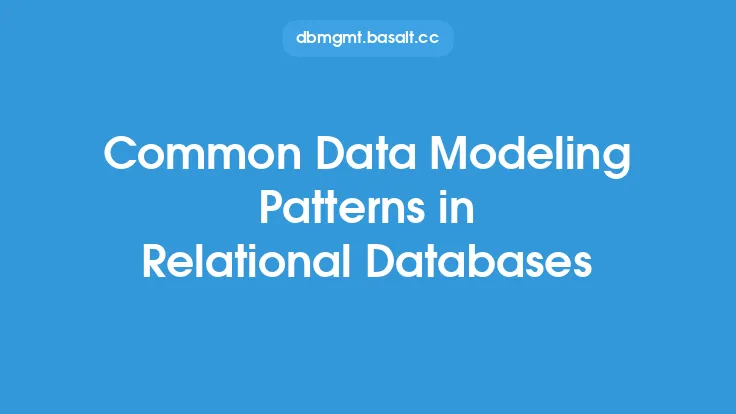Logical data modeling is a crucial step in the design of relational databases, as it allows developers to create a conceptual representation of the data that will be stored in the database. This process involves identifying the entities, attributes, and relationships that are relevant to the database, and organizing them in a way that is consistent with the principles of relational database design. In this article, we will explore the key concepts and techniques involved in logical data modeling for relational databases, and provide guidance on how to create a robust and scalable data model.
Introduction to Relational Databases
Relational databases are a type of database that stores data in tables, with each table consisting of rows and columns. Each row represents a single record, and each column represents a field or attribute of that record. The relationships between tables are established through the use of keys, which are unique identifiers that allow data to be linked across tables. Relational databases are widely used in a variety of applications, from simple web applications to complex enterprise systems, due to their flexibility, scalability, and support for complex queries.
The Logical Data Modeling Process
The logical data modeling process involves several steps, including:
- Identifying the entities that will be represented in the database. Entities are objects or concepts that have independent existence and can be described with attributes.
- Identifying the attributes that describe each entity. Attributes are the individual elements of data that are associated with each entity.
- Defining the relationships between entities. Relationships can be one-to-one, one-to-many, or many-to-many, and are used to establish links between tables.
- Normalizing the data model to minimize data redundancy and improve data integrity.
- Denormalizing the data model, if necessary, to improve performance.
Entity-Relationship Modeling
Entity-relationship modeling is a key component of logical data modeling. It involves identifying the entities, attributes, and relationships that are relevant to the database, and representing them in a graphical format. The entity-relationship model consists of three main components:
- Entities: These are the objects or concepts that are being modeled.
- Attributes: These are the individual elements of data that are associated with each entity.
- Relationships: These are the links between entities, and can be one-to-one, one-to-many, or many-to-many.
Data Types and Attributes
Data types are an essential aspect of logical data modeling, as they define the format and constraints of each attribute. Common data types include integers, strings, dates, and timestamps. Attributes can be further defined with additional constraints, such as nullability, uniqueness, and default values. The choice of data type and attribute constraints can have a significant impact on the performance and scalability of the database.
Relationships and Cardinality
Relationships between entities are established through the use of keys, which are unique identifiers that allow data to be linked across tables. The cardinality of a relationship refers to the number of rows in one table that can be associated with a single row in another table. Common relationship types include:
- One-to-one: A single row in one table is associated with a single row in another table.
- One-to-many: A single row in one table is associated with multiple rows in another table.
- Many-to-many: Multiple rows in one table are associated with multiple rows in another table.
Normalization and Denormalization
Normalization is the process of organizing data in a database to minimize data redundancy and improve data integrity. The normalization process involves applying a set of rules to the data model, which ensure that each piece of data is stored in one place and one place only. Denormalization, on the other hand, involves intentionally violating the principles of normalization to improve performance. Denormalization can be used to reduce the number of joins required to retrieve data, or to pre-aggregate data to improve query performance.
Data Integrity and Constraints
Data integrity is a critical aspect of logical data modeling, as it ensures that the data in the database is accurate, complete, and consistent. Constraints are used to enforce data integrity, and can include rules such as primary keys, foreign keys, and check constraints. Primary keys are used to uniquely identify each row in a table, while foreign keys are used to establish relationships between tables. Check constraints are used to enforce specific rules or conditions on the data, such as ensuring that a date is within a valid range.
Best Practices for Logical Data Modeling
There are several best practices that can be followed to ensure that a logical data model is robust, scalable, and maintainable. These include:
- Keeping the data model simple and intuitive.
- Using meaningful and descriptive names for entities, attributes, and relationships.
- Avoiding unnecessary complexity and redundancy.
- Using data types and constraints to enforce data integrity.
- Normalizing the data model to minimize data redundancy and improve data integrity.
- Denormalizing the data model, if necessary, to improve performance.
- Documenting the data model and its components.
Conclusion
Logical data modeling is a critical step in the design of relational databases, as it allows developers to create a conceptual representation of the data that will be stored in the database. By following the principles and best practices outlined in this article, developers can create a robust and scalable data model that supports the needs of their application. Whether you are building a simple web application or a complex enterprise system, a well-designed logical data model is essential for ensuring data integrity, scalability, and performance.





